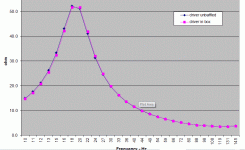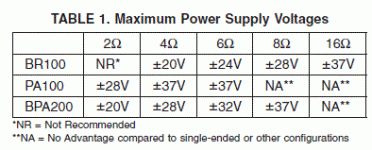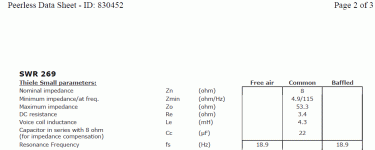ST7677,
Definitely match to the identical gain on all channels & pick a gain in the mid to hi 20s that works well with the output level from your source that will act as the system volume control. I assume your amp build will allow for varying/matching of gains between channels with a pot for each. Good luck!
Definitely match to the identical gain on all channels & pick a gain in the mid to hi 20s that works well with the output level from your source that will act as the system volume control. I assume your amp build will allow for varying/matching of gains between channels with a pot for each. Good luck!
The assumption that the load has 8 Ohm at all frequencies is not correct. No speaker poses a resistive load.confirm that calculations (till Watts required post equalization) are correct.[/B]
View attachment 259779
Both woofers for the Orion are 4 Ohm types, whether you take the Peerless or the Seas. So you should use two parallel chipamps for each woofer and a single ended chipamp for the midrange and tweeter to make use of the same supply voltage. As a side effect you already get double the power for the woofers.
Did you consider to start with 50 W and decide after the first listening test, whether more power is needed at all?Hi Kevin,
The recommended 26DB = 50Watts, so I am going with 29db=100 Watts.
Here is the impedance curve for the woofer. It varies from 3.9 ohms (at 98hz) to 51.3 ohms (at 20hz).

So what impedance should be considered while selecting the amplifier? The impedance is below 8ohm between 50hz to 100hz.
2 LM3886 in bridge mode or 2 LM3886 in parallel mode?
As per National AN1192, two LM3886 in parallel have no additional benefit (over a single LM3886) above 6 ohm load.


So what impedance should be considered while selecting the amplifier? The impedance is below 8ohm between 50hz to 100hz.
2 LM3886 in bridge mode or 2 LM3886 in parallel mode?
As per National AN1192, two LM3886 in parallel have no additional benefit (over a single LM3886) above 6 ohm load.

Last edited:
Here is the impedance curve for the woofer. It varies from 3.9 ohms (at 98hz) to 51.3 ohms (at 20hz).
View attachment 259918
So what impedance should be considered while selecting the amplifier? The impedance is below 8ohm between 50hz to 100hz.
2 LM3886 in bridge mode or 2 LM3886 in parallel mode?
As per National AN1192, two LM3886 in parallel have no additional benefit (over a single LM3886) above 6 ohm load.
View attachment 259919
The data is from the specification sheet so I presume it is correct.
Where do I go from here?
ST7677,
It is clear from your approach and your questions that you are in over your head in trying to approach this most challenging amplifier project as a clean sheet of paper design starting from the fundamentals (BTW so am I!) The ironic thing is that the analysis you keep trying to plow through has already been done by a guy with impeccable credentials...Seigfried Linkwitz.
The fundamental reason to consider Orion is that it is a BIY (build it yourself) as opposed to DIY (design it yourself) speaker project where a gifted engineer has done the hard parts of active 3-way speaker system optimization, leaving you to only buy the IP and the parts and assemble it following good detailed instructions. While he does leave the specific choice of amplification to you, he has established well developed rules of thumb for power requirements, gain, etc. The OPUG blog provides further support as a community of knowledgeable folks who have successfully completed the project and who can, will and have tried to help address questions like those you have raised there and here.
For this to work well you first need to recognize what you are and are not equipped to tackle or else you will keep zigging and zagging through the same questions without ever making any forward progress toward the goal. If you want to approach this project at the level you are now attempting you need to get much deeper into the technical fundamentals, build some single channel chipamp prototypes, test and evaluate them with the various Orion drivers, and make the optimization decisions you are struggling with based on that experience.
On the other hand if you want to take the most direct and reliable path to a successful outcome you need to follow the advice given and buy or build an amplifier that will work well with Orion. Of the two choices I suspect buy is the wise one for you right now as a starting point...then you can enjoy using Orion and gather your own insights into where the system can be improved upon and what amplifier characteristics are most critical. I wish you the best of luck with whichever path you choose!
It is clear from your approach and your questions that you are in over your head in trying to approach this most challenging amplifier project as a clean sheet of paper design starting from the fundamentals (BTW so am I!) The ironic thing is that the analysis you keep trying to plow through has already been done by a guy with impeccable credentials...Seigfried Linkwitz.
The fundamental reason to consider Orion is that it is a BIY (build it yourself) as opposed to DIY (design it yourself) speaker project where a gifted engineer has done the hard parts of active 3-way speaker system optimization, leaving you to only buy the IP and the parts and assemble it following good detailed instructions. While he does leave the specific choice of amplification to you, he has established well developed rules of thumb for power requirements, gain, etc. The OPUG blog provides further support as a community of knowledgeable folks who have successfully completed the project and who can, will and have tried to help address questions like those you have raised there and here.
For this to work well you first need to recognize what you are and are not equipped to tackle or else you will keep zigging and zagging through the same questions without ever making any forward progress toward the goal. If you want to approach this project at the level you are now attempting you need to get much deeper into the technical fundamentals, build some single channel chipamp prototypes, test and evaluate them with the various Orion drivers, and make the optimization decisions you are struggling with based on that experience.
On the other hand if you want to take the most direct and reliable path to a successful outcome you need to follow the advice given and buy or build an amplifier that will work well with Orion. Of the two choices I suspect buy is the wise one for you right now as a starting point...then you can enjoy using Orion and gather your own insights into where the system can be improved upon and what amplifier characteristics are most critical. I wish you the best of luck with whichever path you choose!
agree totally with "kevinahcc20".
DIYing not always flow smoothly as expected, sometimes it takes days to figure out a simple problem in your first DIY amplifier itself. And Here you are talking abt making 16 channels of amplifier, connecting them with power supply and then x-overs... and finally with speakers...
DIYing not always flow smoothly as expected, sometimes it takes days to figure out a simple problem in your first DIY amplifier itself. And Here you are talking abt making 16 channels of amplifier, connecting them with power supply and then x-overs... and finally with speakers...
Hi Kevin,
I understand I am very new to all this. But I am determined to make the amps and then the Orions. I promise I would build the Orions as per SL's design without any re-designing / number crunching
Problem is that, I do not see any similar reference design / designer whom I can blindly follow in DIY amp space.
Meanwhile, I request one of the experienced gentlemen to help me with post 106.
I am pretty close to ordering parts for my first amp.
I would build it, test it, fine tune it and then only build rest of the other channels. With my experience I understand that I can't do the same mistakes in 16 amps...
I understand I am very new to all this. But I am determined to make the amps and then the Orions. I promise I would build the Orions as per SL's design without any re-designing / number crunching
Problem is that, I do not see any similar reference design / designer whom I can blindly follow in DIY amp space.
Meanwhile, I request one of the experienced gentlemen to help me with post 106.
I am pretty close to ordering parts for my first amp.
I would build it, test it, fine tune it and then only build rest of the other channels. With my experience I understand that I can't do the same mistakes in 16 amps...
I don't know, where you got your datasheet from. Rev 1_0 from 12-Apr-10 from the Tymphany homepage states that the XLS10-P830452 is a 4 Ohm woofer.
The amp must be designed for the nominal impedance, when it comes to heatsinking, and for the lowest impedance, when it comes to current capability.
So assuming you use 28 V rails on your 4 Ohm woofer, you can expect that a single chipamp can deliver sufficient current just so, and heatsinking will be on the borderline, too. Based on the knowledge that chipamps tend to produce thermal distortion and reduce the output current limit threshold ever further, the hotter they get, you should absolutely use two LM3886 in parallel for the woofer section.
The amp must be designed for the nominal impedance, when it comes to heatsinking, and for the lowest impedance, when it comes to current capability.
So assuming you use 28 V rails on your 4 Ohm woofer, you can expect that a single chipamp can deliver sufficient current just so, and heatsinking will be on the borderline, too. Based on the knowledge that chipamps tend to produce thermal distortion and reduce the output current limit threshold ever further, the hotter they get, you should absolutely use two LM3886 in parallel for the woofer section.
830452 Data Sheet
Data sheet is here:
http://www.d-s-t.com.au/data/Peerless/830452.pdf
The P830452 must be a variation
jb74
Data sheet is here:
http://www.d-s-t.com.au/data/Peerless/830452.pdf
The P830452 must be a variation
jb74
I think Tymphany has revised the woofer in 2010. As the specifications I have (as shared by JB74, which also match specifications in Linkwitz calculations) are different in all aspects from the new specifications on Tymphany' website.
May be this was the reason SL, dropped Tymphany and switched to Seas woofer in latest version.
That said, looks like the 8 ohm nominal impedance on the earlier data sheet seems to be a typo.
May be this was the reason SL, dropped Tymphany and switched to Seas woofer in latest version.
That said, looks like the 8 ohm nominal impedance on the earlier data sheet seems to be a typo.
Both woofers for the Orion are 4 Ohm types, whether you take the Peerless or the Seas. So you should use two parallel chipamps for each woofer and a single ended chipamp for the midrange and tweeter to make use of the same supply voltage. As a side effect you already get double the power for the woofers.
Hi Pacificblue,
Can you please explain how do you effectively get double the power for the woofers? The available voltage remains 28.3V. Whether you call it 50W @ 8 ohms or 100W at 4 ohms its the same thing, because the woofer is 4 ohms.
The woofer excursion is voltage limited and not current limited till 92 hz (the intended range), though the amp does reach the 7amp max limit and the thermal limit. So in my view the advantage of parallel amps will be lower heat dissipation at each chip and hence possibly lower chances of related distortion.
I do not think it will make any output difference between single amp and parallel amps.
Also the LM3886 spec sheet says output current limit is 7amps (guaranteed) and 11.5 amps typical. So can we not assume that most amps will have close to 11 amps available. Not sure how to interpret this.
Last edited:
The data is from the specification sheet so I presume it is correct.
you must learn to interpret what you read and become effective at separating the "wheat from the chaff".......... looks like the 8 ohm nominal impedance on the earlier data sheet seems to be a typo.
The internet is not a reliable resource. Always look for some form of independent corroboration.
Yes, you are right, I am skeptical.
the National data is generally compiled from tests carried out at 25degC for Tc and Ta and infinite heatsinks.........Also the LM3886 spec sheet says output current limit is 7amps (guaranteed) and 11.5 amps typical. So can we not assume that most amps will have close to 11 amps available. Not sure how to interpret this.
Unless they tell you otherwise, National use these temperature conditions to show their chipamp performance in the best light.
The guaranteed maximum and the typical maximum, will both fall as Tc increases. There is a graph showing some of that effect at elevated temperature.
But National also show performance driving a resistive load.
Performance into a reactive speaker load is very different.
Two of the biggest differences show up in stability into reactive loading and peak current demand into real speakers.
How about BPA200 (bridge parallel amp) with 2 LM3886 in parallel on each leg of bridge, to drive the two woofers in parallel?
As per AN1192, it is rated at 335W continuous at 4 ohm (28V) and 450W burst clipping power. It is also 2ohm stable (at 20V).
As per linkwitz website ORION construction kit
"If the two 10" drivers of the woofer are connected in parallel, then they present a low 2 ohm impedance to the power amplifier around 100 Hz. The power amplifier driving this load must be capable of at least 200 W into 4 ohm."
As per AN1192, it is rated at 335W continuous at 4 ohm (28V) and 450W burst clipping power. It is also 2ohm stable (at 20V).
As per linkwitz website ORION construction kit
"If the two 10" drivers of the woofer are connected in parallel, then they present a low 2 ohm impedance to the power amplifier around 100 Hz. The power amplifier driving this load must be capable of at least 200 W into 4 ohm."
Did you consider to start with 50 W and decide after the first listening test, whether more power is needed at all?
Personally I haven't yet but I have read lot of opinions from Orion owners (on Orion forum) that woofers are under powered and doubling power improves the low end.
SL himself acknowledges that, but he prefers to put power on lower side to avoid bottoming out woofer at lower frequencies. With recent Seas woofer upgrade he recommends 180W power amp.
It is not the same thing. If the woofer is 4 Ohms, you get 100 W. If the woofer is 8 Ohm, you get 50 W. If Linkwitz recommends 50 W, then 100 W is double as much, and it is also double as much as the 50 W you get on the 8 Ohm midrange and tweeter.Whether you call it 50W @ 8 ohms or 100W at 4 ohms its the same thing, because the woofer is 4 ohms.
According to the datasheet you can expect 30-38 W into 8 Ohm and 60-68 W into 4 Ohm from 28 V rails. If you want 50 W into 8 Ohm, you'll need 35 V rails, and with those you will be obliged to use a parallel configuration for the 4 Ohm woofer.
The LM3886 has the SPIKe system on board. That system reduces the output current according to the LM's temperature. You can read about the details in National's AN-898. It will reduce the output power to protect the amp. If you want to keep it from doing that, you need good heatsinking and a parallel configuration improves that a lot.So in my view the advantage of parallel amps will be lower heat dissipation at each chip and hence possibly lower chances of related distortion.
I do not think it will make any output difference between single amp and parallel amps.
That is the point. You cannot be sure how to interpret it, because the statistical data for interpretation is missing. The datasheet doesn't tell you if typical means the statistical average, the median, a certain percentage or whatever. And even if 99 % of all amps achieve 11 A, you may still happen to get the ones that belong to the remaining 1 %.Also the LM3886 spec sheet says output current limit is 7amps (guaranteed) and 11.5 amps typical. So can we not assume that most amps will have close to 11 amps available. Not sure how to interpret this.
And that is followed by the recommendation to use one amp per woofer to avoid just that.As per linkwitz website ORION construction kit
"If the two 10" drivers of the woofer are connected in parallel, then they present a low 2 ohm impedance to the power amplifier around 100 Hz. The power amplifier driving this load must be capable of at least 200 W into 4 ohm."
But you could still.Personally I haven't yet
- Status
- This old topic is closed. If you want to reopen this topic, contact a moderator using the "Report Post" button.
- Home
- Amplifiers
- Chip Amps
- LM3886 based 8 Channel amps for linkwitz Orion
